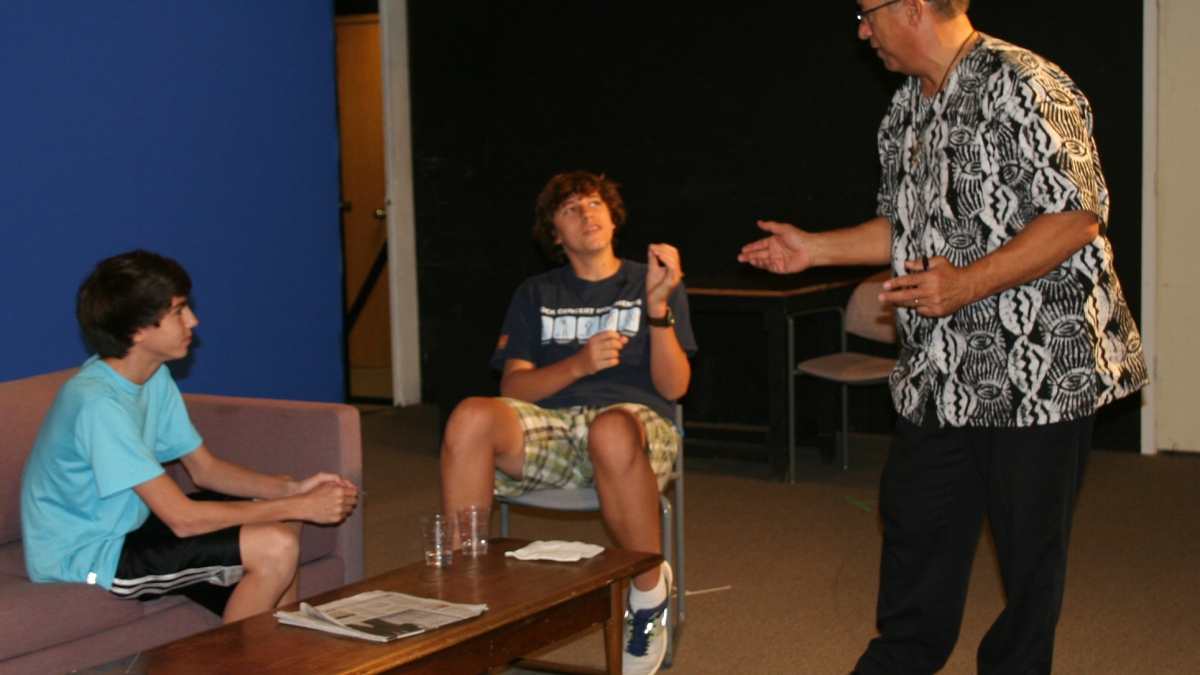Gifted youngsters hone their acting skills in university class

If Shakespeare was correct in claiming that all the world’s a stage, it makes sense for young people to get an early start at feeling comfortable on that stage … or in front of the camera. Four students from ASU’s Gary K. Herberger Young Scholars Academy are doing just that, spending the fall semester auditing the Acting for the Camera class offered through the New College of Interdisciplinary Arts and Sciences.
The students, age 13 to 14, are in their second year at the Herberger Academy, an initiative of ASU’s Mary Lou Fulton Teachers College. The school located on the West campus provides a highly challenging and hands-on learning environment for gifted adolescents.
Acting for the Camera is taught by multiple Emmy winner Charles St. Clair, a faculty member in New College’s School of Humanities, Arts and Cultural Studies (SHArCS). It is offered as part of the bachelor’s degree program in interdisciplinary arts and performance (IAP). IAP students study the arts and digital media with an emphasis on 20th and 21st century arts, performance, technology and practice. The program encourages practical application of theory and content area knowledge with the integration of skills and performance. IAP courses highlight creativity, innovation, integration and presentation.
Presentation skills are emphasized in Acting for the Camera. Students must memorize their lines and perform commercials, public service announcements, monologues, movie scenes and soap opera scenes.
“I am very interested in the prospect of pursuing acting,” said Herberger Academy student Brett Cohen. “It’s already high in my career list, and the great thing is that even at my age you can still get acting jobs. We aren’t really treated differently from the other students in the class. We joke and learn just as the college students do, and I think it’s a great experience and preparation to learn to talk to adults.”
“To a large extent a student’s success in this class is based on fortitude and a desire to succeed, not on years of acting experience,” said St. Clair, who has more than 400 major productions to his credit in theater, film and video. “The Herberger students participate fully in the class and get the same critiques of their acting as the other students. All of the students quickly come to realize that this is not a competition – we’re all here to learn, and the way to do so is by setting and reaching goals.”
“Charles St. Clair is a very dedicated and serious professor who is wonderful to interact with because he tells you exactly how to improve,” said Zweygardt. “While he is sympathetic to our age, he does a fantastic job at giving fair and equal feedback, and the other students in the class are kind and respectful.”
Added Slosky, “The experience has been incredibly fun and interactive, because we are receiving the same opportunities as the college students. We are gaining not just knowledge about how to act in front of the camera for film and commercials, but it is helping our presentation skills in general.”
“Students of all ages come to the Acting for the Camera class to use the skills they learn in a variety of career choices,” St. Clair said. “Acting is a science. You make choices and you keep refining them until you have created a piece of art worthy of being viewed with some level of believability.”
Kimberly Lansdowne, executive director of the Heberger Academy, says St. Clair is providing exactly the type of guidance and mentorship that can help Academy students grow socially and emotionally as well as intellectually, and he is not the only New College faculty member to do so.
“One of the primary goals of the Herberger Young Scholars Academy is to have students interface with university professors,” Lansdowne said. “We have been fortunate to have the support of New College in many different ways. Our students are working with Chad Johnson and Susie Sandrin on a research study of black widow spiders, participating in a calculus class with Stephen Wirkus, using the university science labs, and taking a drama class with Charles St. Clair. It’s an extremely rich experience for students to be working on high school graduation requirements at the Herberger Academy while, at the same time, interacting with university faculty.”
Zweygardt said participating in the Acting for the Camera class has been a challenge, but one that provides rewarding payoffs.
“Trying to fully analyze the character that you have been asked to become isn’t easy. But it’s also fun because if you are successful, it is the greatest feeling in the world to know that you have been understood,” Zweygardt said.
The IAP degree program enables students to be understood through their creative endeavors in a range of artistic fields, said Marlene Tromp, director of SHArCS.
“Our IAP program offers a cutting-edge approach to the arts – in part because of the ways in which technology can be blended with traditional artistic practices and in part because the program is genuinely interdisciplinary, bringing students into the material from a range of perspectives, intellectually and creatively,” Tromp said. “From the sound studio to the stage to the digital environment, our students have the opportunity to grow exponentially as they make art. We also have the good fortune to have a world-class faculty that strives to serve the students and to provide great role models of innovative art themselves.”